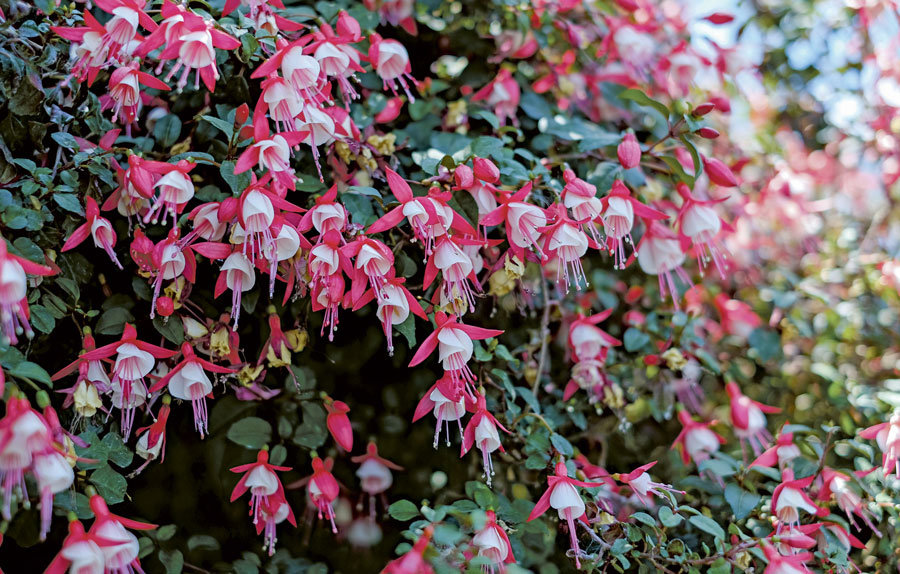
There is something about fuchsias, especially the upright hardy varieties.
Ask Lorrie Moulton, Barb Rowland and Dale Skrivanich — all members of the LakeBay (sic) Fuchsia Society — what draws them to these plants.
Hummingbirds love them. They come in all shapes and sizes. Heights range from 5 inches to 6 feet. Leaves may be soft and velvety or shiny and smooth, with colors from chartreuse to dark green, solid to variegated. Flowers come in countless shapes and configurations and range from the size of a small fingernail to several inches. Popular flower colors cycle from year to year, and they come in every hue but yellow. “The first person who breeds a yellow fuchsia will be the next Bill Gates,” Skrivanich said.
You can plan a whole garden around fuchsias. “What is fun is that you can do far more with them than with dahlias. With a dahlia you are just stuck, and they can get earwigs,” Rowland said. “Fuchsias are just pretty. If you are careful, they don’t get blackspot or aphids like my roses do. They are relatively easy to grow. If you take reasonable care, you will be well-rewarded.”
If you don’t have a large enough garden, they do well in containers. “Lorrie is a master at containers,” Skrivanich said. “And she has bonsai fuchsias, too.”
In addition, they can be used in kokedama — a Japanese art of packing roots in a mud ball then covering the ball with moss. The plants can then be displayed as part of floral arrangements or as hangings. Skrivanich hangs hers from trees in her yard.
Although hardy fuchsias will survive the northwest winters, some need to be protected in cold frames or greenhouses. Others do fine if they have the protection of surrounding ferns or maple leaves. “You have to remember, ‘the right place for the right plant,’ ” Skrivanich said.
Fuchsias were first described scientifically in the late 1600s by a French monk and botanist visiting Hispaniola — now Haiti and the Dominican Republic. Most species are native to South America, but they have been found in Central America, Mexico, New Zealand and Tahiti. Hybridizers got to work and both careful crossbreeding and lucky accidents have led to more than 1,000 varieties. Gardeners in Great Britain once lined driveways with plants that grew 8 to 10 feet high. Their popularity peaked during World War I until the greenhouses used to grow them were taken over for food production. Interest continued, though, and the American Fuchsia Society was established in 1929.
The LakeBay Fuchsia Society is one of 13 members of the Northwest Fuchsia Society and although Skrivanich — who is also a Pierce County Master Gardener — is one of the local resident experts, she credits Sharon Miller with much of what she knows.
“She is a walking encyclopedia,” Skrivanich said. “I wouldn’t know a fuchsia from a tomato if it wasn’t for her.”
Miller, who now lives in Tacoma, founded the group when she moved to the Key Peninsula. After meeting informally for several years, the Society became official in 1995. A few years later it took over a former parking area at the Key Peninsula Civic Center and transformed it into a garden. “It took heavy equipment to loosen the dirt, it was so hard-packed by years of cars,” Skrivanich said. The Society still maintains it, weeding, trimming and replanting as needed.
“We have always gone on, despite illnesses, deaths and now a pandemic,” Skrivanich said. They have about 30 dues-paying members. “We are like a family. We had our first meeting in over a year in June and it was like we had never not had a meeting. We would be friends without the fuchsias.”
Meetings, held the first Thursday of each month at the Key Peninsula Civic Center, include a presentation on a gardening topic of general interest and a “fuchsia corner” to talk about fuchsia-related issues. “New members are welcomed right in,” Rowland said. “We have a welcome packet and if you come knowing nothing about fuchsias you won’t be intimidated. We want you to grow fuchsias and enjoy them.”
UNDERWRITTEN BY THE FUND FOR NONPROFIT NEWS (NEWSMATCH) AT THE MIAMI FOUNDATION, THE ANGEL GUILD, ADVERTISERS, DONORS AND PEOPLE WHO SUPPORT INDEPENDENT, NONPROFIT LOCAL NEWS